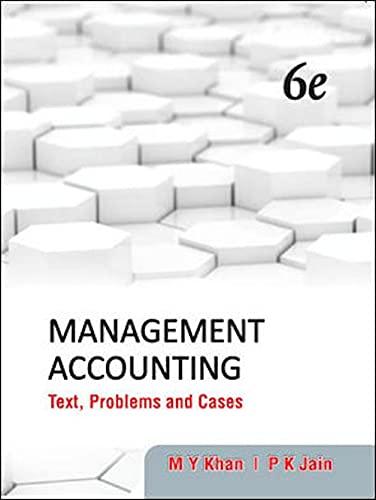(a) Indicate whether the followings statements are True or False. (i) Process costing is appropriate when the...
Question:
(a) Indicate whether the followings statements are ‘True’ or ‘False’.
(i) Process costing is appropriate when the output is heterogeneous and/or the production process is generally intermittent.
(ii) In process costing, unit cost is determined periodically.
(iii) Less amount of inventory needs to be maintained in process costing as compared to job costing.
(iv) Job costing and process costing are mutually exclusive systems of costing.
(v) Process costing usually does not include a work-in-process account.
(vi) In process costing, the units of production in process need to be converted into equivalent units.
(vii) 100 units of inventory estimated to be 40 per cent complete are considered equivalent to 60 per cent completed units.
(viii) The split of production cost into
(a) cost of output, and
(b) closing inventory would remain same in FIFO as well as weighted average method of valuing work-in-process closing inventory.
(ix) In process costing, both normal and abnormal losses are controllable losses.
(x) Normal spoilage and abnormal spoilage are treated as product cost in process costing.
(xi) Abnormal spoilage cost is treated as a period cost and is written off as a loss in the period in which it occurs.
(xii) Transfer of output from one process to another can be either at cost or at market/inflated prices.
(xiii) The cost basis of inter-process transfer of output is better than market price basis.
(xiv) In process costing, production normally precedes sales.
(xv) Normal spoilage forms part of product costs.
(xvi) Normal loss is a controllable loss.
(xvii) Production costs incurred after the split-off point are joint costs.
(xviii) Physical quantities method results in identical unit costs for each product.
(b) In the following multiple choice questions, select the correct answers.
The following data of ABC Ltd. is given below.
Process I — Raw material charged — 600 kg @ ₹4/kg.
— Direct labour ₹200.
— Departmental expenses ₹760.
— Normal loss is 10 per cent of input.
— During the period actual production was 500 kg and 100 kg was scrap. The scrap is sellable at ₹2/kg.
(xix) Calculate cost per unit which is cost per unit for ABC Ltd.
(a) ₹6 per unit,
(b) ₹5.6 per unit,
(c) ₹5 per unit,
(d) None of these.
(xx) What is the amount of effective abnormal loss for ABC Ltd.?
(a) ₹240,
(b) ₹160,
(c) ₹200,
(d) None of these.
Step by Step Answer:

Management Accounting Text Problems And Cases
ISBN: 9781259026683
6th Edition
Authors: M Y Khan, P K Jain





